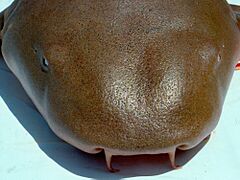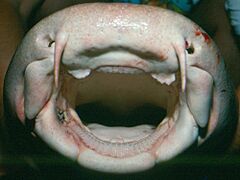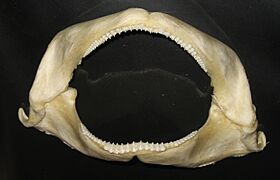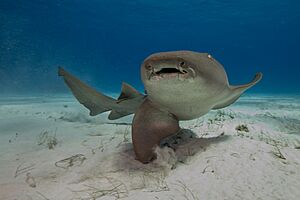Nurse shark facts for kids
Quick facts for kids Nurse shark |
|
|---|---|
 |
|
| A nurse shark resting at Gray's Reef National Marine Sanctuary, Sapelo Island, Georgia | |
| Conservation status | |
| Scientific classification | |
| Genus: |
Ginglymostoma
|
| Species: |
cirratum
|
 |
|
| Where nurse sharks live (blue areas) | |
The nurse shark (Ginglymostoma cirratum) is a bottom-dwelling shark that belongs to the Ginglymostomatidae family. They range in length from 2.1-2.7 metres, and weigh 75-120 kg. These sharks are known for being quite calm and often rest on the seafloor.
The scientific name for the nurse shark, Ginglymostoma, comes from Greek language words that mean "hinged mouth." The second part of its name, cirratum, comes from Latin and means "having curled ringlets," which might refer to the barbels (whisker-like feelers) near its mouth.
Nurse sharks are listed as Vulnerable on the IUCN List of Threatened Species. This means their population is decreasing in many parts of the world. While they are doing better in places like the United States and The Bahamas, they are considered "near threatened" in the western Atlantic Ocean.
Scientists believe that Ginglymostoma is closely related to another shark genus called Nebrius. Both of these are part of a larger group that includes other famous sharks like Pseudoginglymostoma brevicaudatum, the whale shark, and the zebra shark.
Contents
What's in a Name?
The common name "nurse" might have come from old English words. The Oxford English Dictionary suggests that in medieval times, the letter "n" from the word "an" was sometimes moved to the beginning of the next word if it started with a vowel. So, old names for sharks like "huss" or "hurse" might have become "nurse."
Description
Nurse sharks have a few distinct features. They have two rounded fins on their back (dorsal fins), rounded fins near their gills (pectoral fins), a long tail fin (caudal fin), and a wide head. The largest nurse sharks found today are about 3.08 m (10 ft 1+1⁄2 in) long. Older reports of them being much larger (up to 4.5 m (15 ft) and weighing 330 kg (730 lb)) are probably not accurate. Adult nurse sharks are usually brownish in color.
When nurse sharks are first born, they are only about 30 cm long and have a spotted pattern on their skin. These spots fade away as they grow older.
Where Do Nurse Sharks Live?
Nurse sharks can be found in many different places, but their populations are spread out. They live in warm, tropical, and subtropical coastal waters. You can find them in the Eastern Atlantic Ocean (from Cape Verde to Gabon), the Western Atlantic Ocean (including the Caribbean, from Rhode Island to southern Brazil), and the East Pacific Ocean (from Baja California to Peru).
Nurse sharks typically live close to shore, usually on the bottom of the ocean. Young nurse sharks often hang out in shallow coral reefs, seagrass beds, and around mangrove islands. Older, larger nurse sharks prefer deeper reefs and rocky areas. During the day, they like to hide in cracks and under ledges. At night, they leave their shelters to search for food on the seabed in shallower waters.
Some nurse sharks have a special genetic condition called piebaldism. This means they have a partial lack of color in their skin, which gives them a speckled or patchy appearance.
What Do Nurse Sharks Eat?
Nurse sharks are "opportunistic predators," meaning they eat whatever small prey they can find. Their diet mainly consists of small fish (like stingrays and other bony fish) and various invertebrates (like crustaceans such as crabs, molluscs like snails, sea urchins, and sea squirts). They also sometimes eat algae.
Nurse sharks are usually active at night (nocturnal). They are often solitary, meaning they hunt alone, sifting through the sand and mud on the seafloor to find food. However, during the day, they often gather in large, inactive groups, resting together.
Nurse sharks are amazing "suction feeders." They can create some of the strongest suction forces recorded for any water animal! Even though their mouths are small, they can suck in prey. If a food item is too big, they might suck it in and spit it out, or shake their head violently to break it into smaller pieces.
Behavior
Unlike many other shark species, nurse sharks are very sedentary, meaning they don't move around much. They show strong "site fidelity," which means they tend to stay in the same area, much like other reef sharks. What's even more interesting is that they are one of the few shark species known to return to the exact same breeding grounds year after year to mate.
Predators
In some coastal areas, American alligators (Alligator mississippiensis) and American crocodiles (Crocodylus acutus) might occasionally hunt nurse sharks. Pictures and old stories suggest that these animals often encounter each other where they share habitats.
Reproduction
Nurse sharks are ovoviviparous. This means that the fertilized eggs hatch inside the mother's body, and the pups are born live. Female nurse sharks have a mating cycle that happens every two years, meaning it takes them up to 18 months to get ready to produce a new set of eggs.
The mating season for nurse sharks is usually from late June to the end of July. After mating, the mother carries the pups for about six months. A typical litter (group of babies) has between 21 and 29 pups. When they are born, young nurse sharks are fully developed and about 30 cm long.
Why are Nurse Sharks Important?
Nurse sharks are very useful for scientists who study sharks. They are tough and can handle being caught, handled, and tagged without getting too stressed. Even though they seem gentle, nurse sharks are actually ranked fourth for documented shark bites on humans! This usually happens because divers or swimmers get too close or try to interact with them, thinking they are completely harmless due to their calm nature. It's always important to give wild animals their space.
See also
 In Spanish: Tiburón gato para niños
In Spanish: Tiburón gato para niños
- List of sharks
- List of prehistoric cartilaginous fish
- Great white shark









